MATH111 Essay: Analyzing Medical Data Using Graphical Representations
VerifiedAdded on 2023/03/17
|7
|1394
|99
Essay
AI Summary
This essay explores the application of graphical representations in medical analysis, focusing on how different types of graphs are utilized to interpret and analyze patient data. The essay begins by introducing the concept of graphical representation of data and its importance in scientific analysis. It then describes various graph types, including linear, bar, and pie charts, illustrating their applications with relevant examples. The core of the essay focuses on the use of graphs in medical diagnostics, highlighting how they are used to obtain crucial patient information and assess various medical conditions. Examples include the visualization of patient pain scales, respiration rates, pulse rates, and blood pressure. The essay emphasizes the benefits of using graphs in medical analysis, such as assisting doctors in making informed decisions, adjusting medications, and monitoring patient progress. The essay concludes by summarizing the wide range of usability of graphs as a mathematical concept in helping medical experts analyze the information of their different patients.
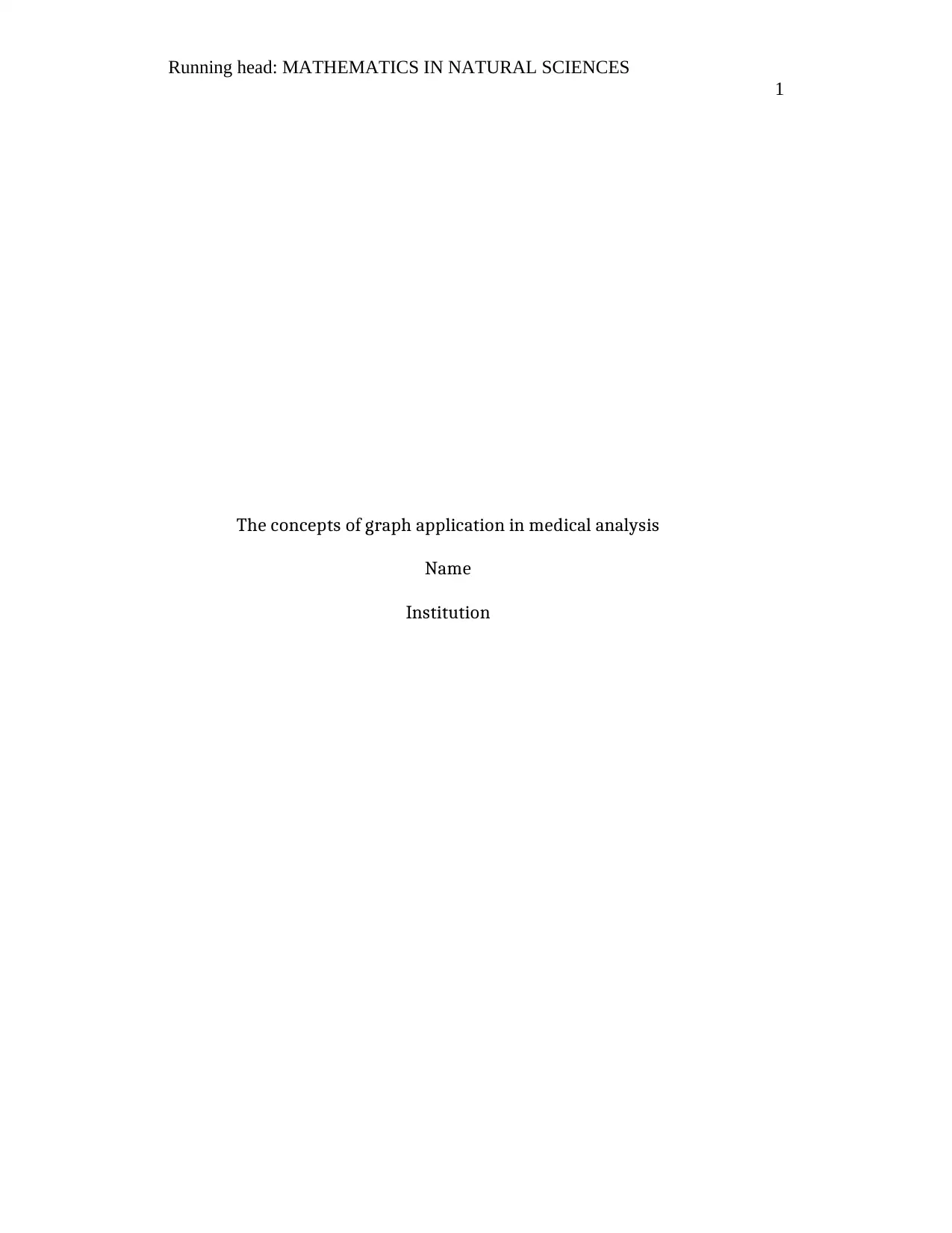
Running head: MATHEMATICS IN NATURAL SCIENCES
1
The concepts of graph application in medical analysis
Name
Institution
1
The concepts of graph application in medical analysis
Name
Institution
Paraphrase This Document
Need a fresh take? Get an instant paraphrase of this document with our AI Paraphraser
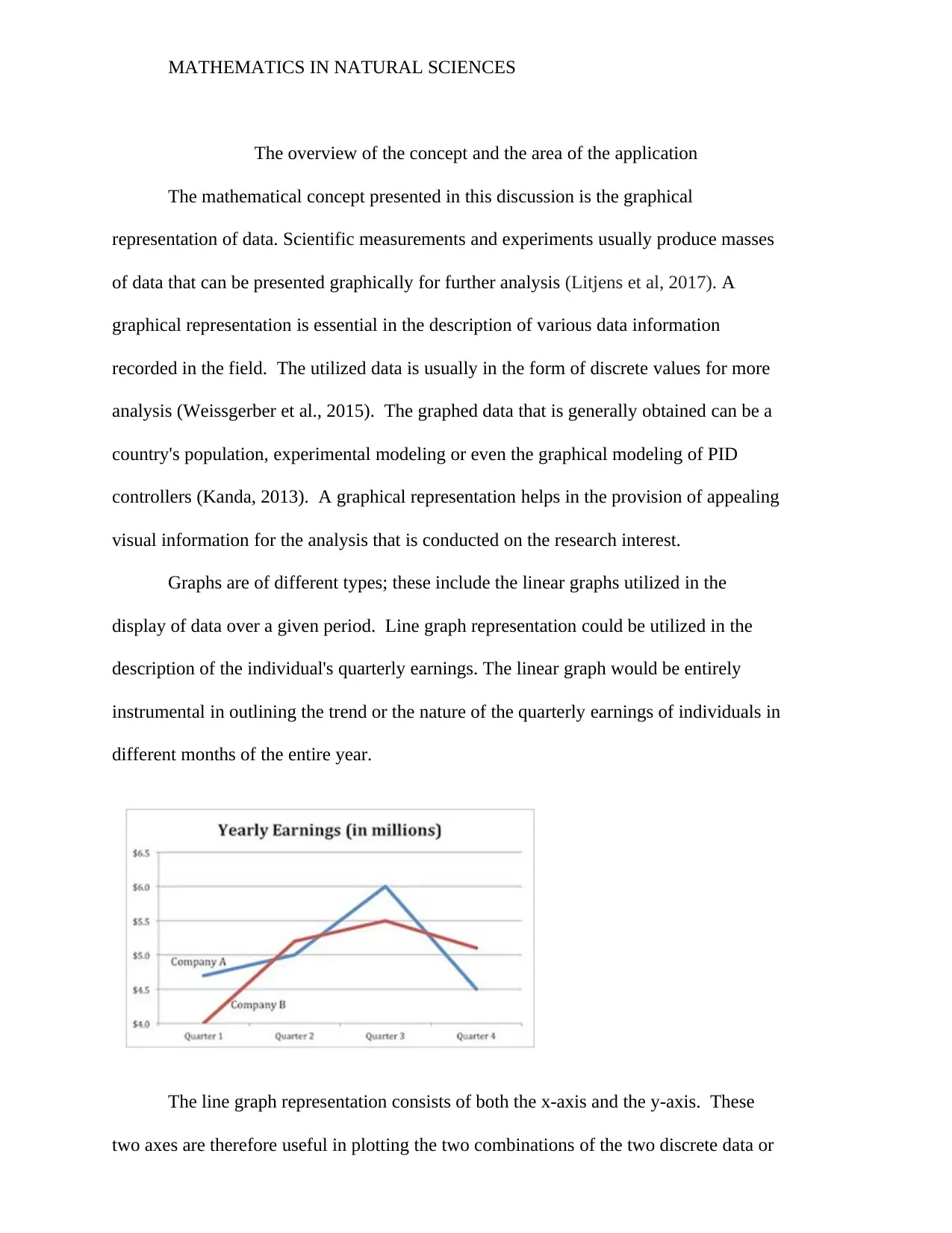
MATHEMATICS IN NATURAL SCIENCES
The overview of the concept and the area of the application
The mathematical concept presented in this discussion is the graphical
representation of data. Scientific measurements and experiments usually produce masses
of data that can be presented graphically for further analysis (Litjens et al, 2017). A
graphical representation is essential in the description of various data information
recorded in the field. The utilized data is usually in the form of discrete values for more
analysis (Weissgerber et al., 2015). The graphed data that is generally obtained can be a
country's population, experimental modeling or even the graphical modeling of PID
controllers (Kanda, 2013). A graphical representation helps in the provision of appealing
visual information for the analysis that is conducted on the research interest.
Graphs are of different types; these include the linear graphs utilized in the
display of data over a given period. Line graph representation could be utilized in the
description of the individual's quarterly earnings. The linear graph would be entirely
instrumental in outlining the trend or the nature of the quarterly earnings of individuals in
different months of the entire year.
The line graph representation consists of both the x-axis and the y-axis. These
two axes are therefore useful in plotting the two combinations of the two discrete data or
The overview of the concept and the area of the application
The mathematical concept presented in this discussion is the graphical
representation of data. Scientific measurements and experiments usually produce masses
of data that can be presented graphically for further analysis (Litjens et al, 2017). A
graphical representation is essential in the description of various data information
recorded in the field. The utilized data is usually in the form of discrete values for more
analysis (Weissgerber et al., 2015). The graphed data that is generally obtained can be a
country's population, experimental modeling or even the graphical modeling of PID
controllers (Kanda, 2013). A graphical representation helps in the provision of appealing
visual information for the analysis that is conducted on the research interest.
Graphs are of different types; these include the linear graphs utilized in the
display of data over a given period. Line graph representation could be utilized in the
description of the individual's quarterly earnings. The linear graph would be entirely
instrumental in outlining the trend or the nature of the quarterly earnings of individuals in
different months of the entire year.
The line graph representation consists of both the x-axis and the y-axis. These
two axes are therefore useful in plotting the two combinations of the two discrete data or
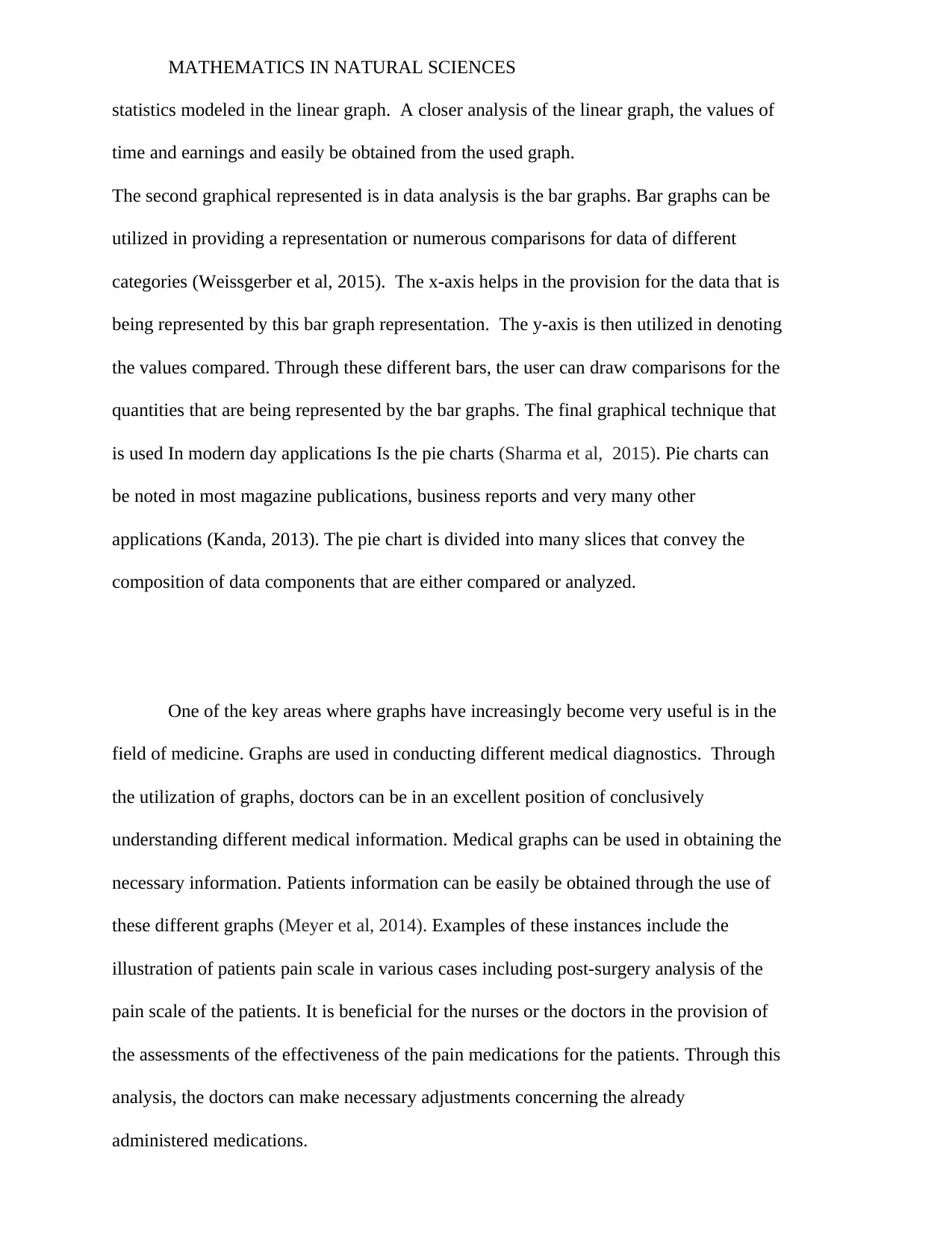
MATHEMATICS IN NATURAL SCIENCES
statistics modeled in the linear graph. A closer analysis of the linear graph, the values of
time and earnings and easily be obtained from the used graph.
The second graphical represented is in data analysis is the bar graphs. Bar graphs can be
utilized in providing a representation or numerous comparisons for data of different
categories (Weissgerber et al, 2015). The x-axis helps in the provision for the data that is
being represented by this bar graph representation. The y-axis is then utilized in denoting
the values compared. Through these different bars, the user can draw comparisons for the
quantities that are being represented by the bar graphs. The final graphical technique that
is used In modern day applications Is the pie charts (Sharma et al, 2015). Pie charts can
be noted in most magazine publications, business reports and very many other
applications (Kanda, 2013). The pie chart is divided into many slices that convey the
composition of data components that are either compared or analyzed.
One of the key areas where graphs have increasingly become very useful is in the
field of medicine. Graphs are used in conducting different medical diagnostics. Through
the utilization of graphs, doctors can be in an excellent position of conclusively
understanding different medical information. Medical graphs can be used in obtaining the
necessary information. Patients information can be easily be obtained through the use of
these different graphs (Meyer et al, 2014). Examples of these instances include the
illustration of patients pain scale in various cases including post-surgery analysis of the
pain scale of the patients. It is beneficial for the nurses or the doctors in the provision of
the assessments of the effectiveness of the pain medications for the patients. Through this
analysis, the doctors can make necessary adjustments concerning the already
administered medications.
statistics modeled in the linear graph. A closer analysis of the linear graph, the values of
time and earnings and easily be obtained from the used graph.
The second graphical represented is in data analysis is the bar graphs. Bar graphs can be
utilized in providing a representation or numerous comparisons for data of different
categories (Weissgerber et al, 2015). The x-axis helps in the provision for the data that is
being represented by this bar graph representation. The y-axis is then utilized in denoting
the values compared. Through these different bars, the user can draw comparisons for the
quantities that are being represented by the bar graphs. The final graphical technique that
is used In modern day applications Is the pie charts (Sharma et al, 2015). Pie charts can
be noted in most magazine publications, business reports and very many other
applications (Kanda, 2013). The pie chart is divided into many slices that convey the
composition of data components that are either compared or analyzed.
One of the key areas where graphs have increasingly become very useful is in the
field of medicine. Graphs are used in conducting different medical diagnostics. Through
the utilization of graphs, doctors can be in an excellent position of conclusively
understanding different medical information. Medical graphs can be used in obtaining the
necessary information. Patients information can be easily be obtained through the use of
these different graphs (Meyer et al, 2014). Examples of these instances include the
illustration of patients pain scale in various cases including post-surgery analysis of the
pain scale of the patients. It is beneficial for the nurses or the doctors in the provision of
the assessments of the effectiveness of the pain medications for the patients. Through this
analysis, the doctors can make necessary adjustments concerning the already
administered medications.
⊘ This is a preview!⊘
Do you want full access?
Subscribe today to unlock all pages.

Trusted by 1+ million students worldwide
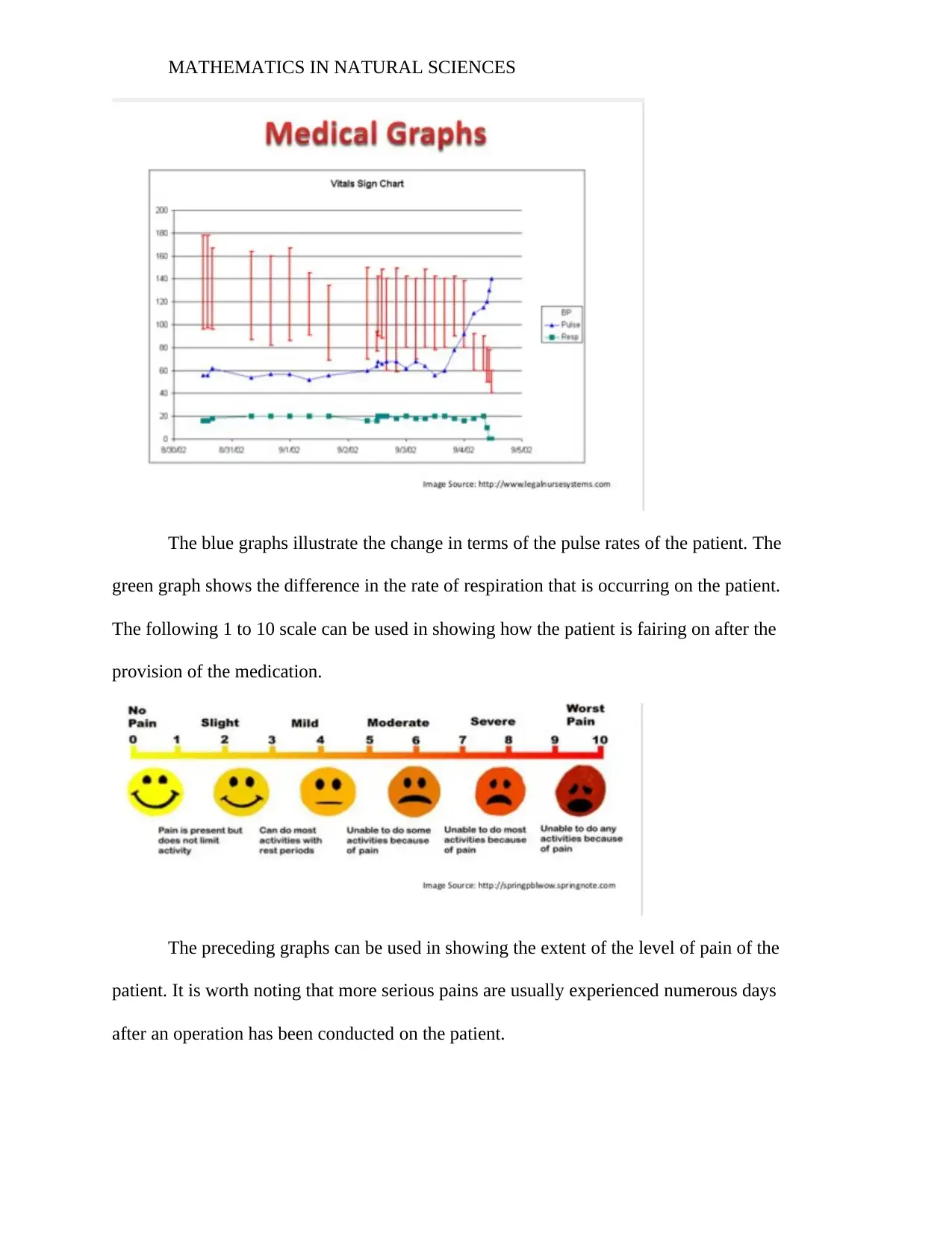
MATHEMATICS IN NATURAL SCIENCES
The blue graphs illustrate the change in terms of the pulse rates of the patient. The
green graph shows the difference in the rate of respiration that is occurring on the patient.
The following 1 to 10 scale can be used in showing how the patient is fairing on after the
provision of the medication.
The preceding graphs can be used in showing the extent of the level of pain of the
patient. It is worth noting that more serious pains are usually experienced numerous days
after an operation has been conducted on the patient.
The blue graphs illustrate the change in terms of the pulse rates of the patient. The
green graph shows the difference in the rate of respiration that is occurring on the patient.
The following 1 to 10 scale can be used in showing how the patient is fairing on after the
provision of the medication.
The preceding graphs can be used in showing the extent of the level of pain of the
patient. It is worth noting that more serious pains are usually experienced numerous days
after an operation has been conducted on the patient.
Paraphrase This Document
Need a fresh take? Get an instant paraphrase of this document with our AI Paraphraser
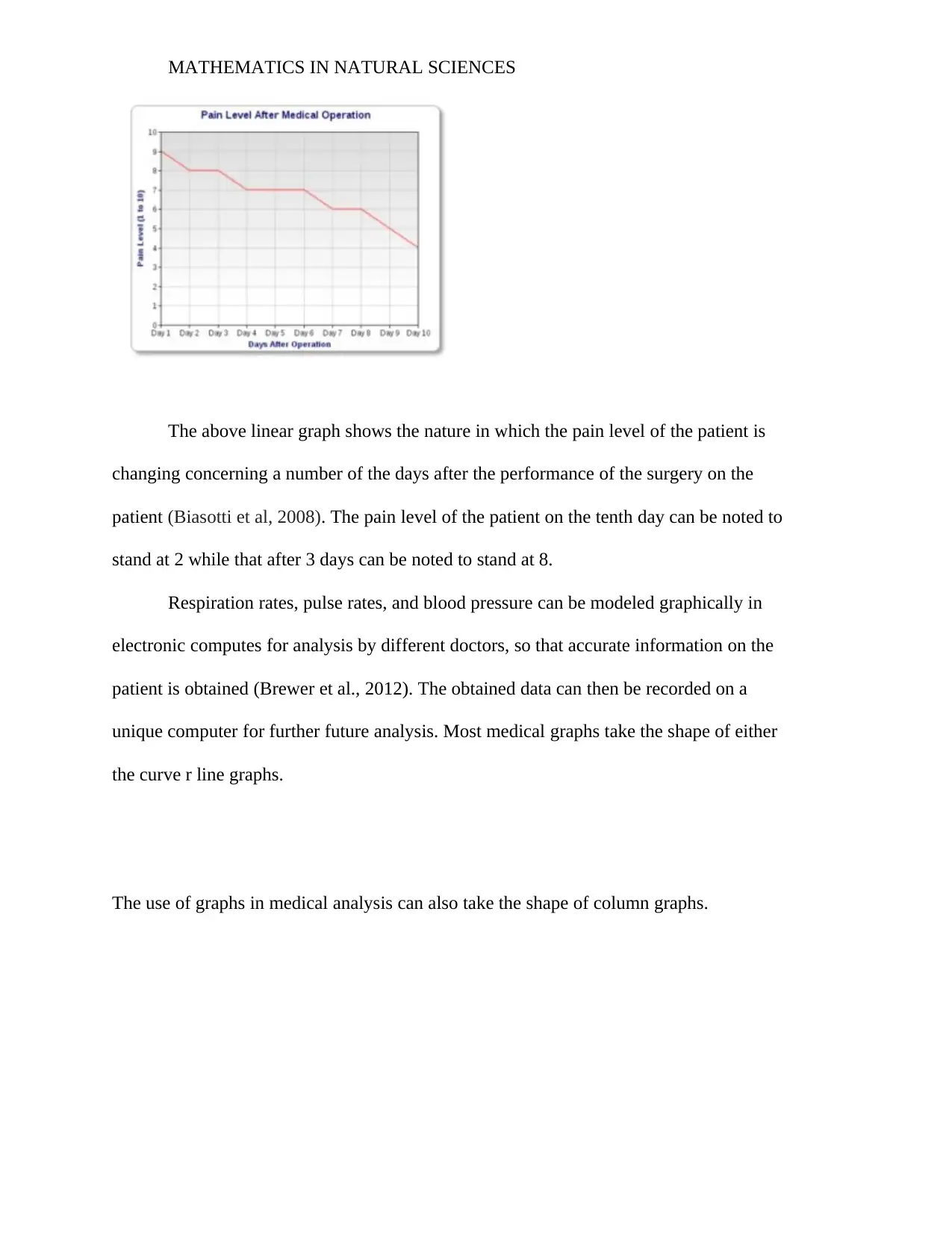
MATHEMATICS IN NATURAL SCIENCES
The above linear graph shows the nature in which the pain level of the patient is
changing concerning a number of the days after the performance of the surgery on the
patient (Biasotti et al, 2008). The pain level of the patient on the tenth day can be noted to
stand at 2 while that after 3 days can be noted to stand at 8.
Respiration rates, pulse rates, and blood pressure can be modeled graphically in
electronic computes for analysis by different doctors, so that accurate information on the
patient is obtained (Brewer et al., 2012). The obtained data can then be recorded on a
unique computer for further future analysis. Most medical graphs take the shape of either
the curve r line graphs.
The use of graphs in medical analysis can also take the shape of column graphs.
The above linear graph shows the nature in which the pain level of the patient is
changing concerning a number of the days after the performance of the surgery on the
patient (Biasotti et al, 2008). The pain level of the patient on the tenth day can be noted to
stand at 2 while that after 3 days can be noted to stand at 8.
Respiration rates, pulse rates, and blood pressure can be modeled graphically in
electronic computes for analysis by different doctors, so that accurate information on the
patient is obtained (Brewer et al., 2012). The obtained data can then be recorded on a
unique computer for further future analysis. Most medical graphs take the shape of either
the curve r line graphs.
The use of graphs in medical analysis can also take the shape of column graphs.
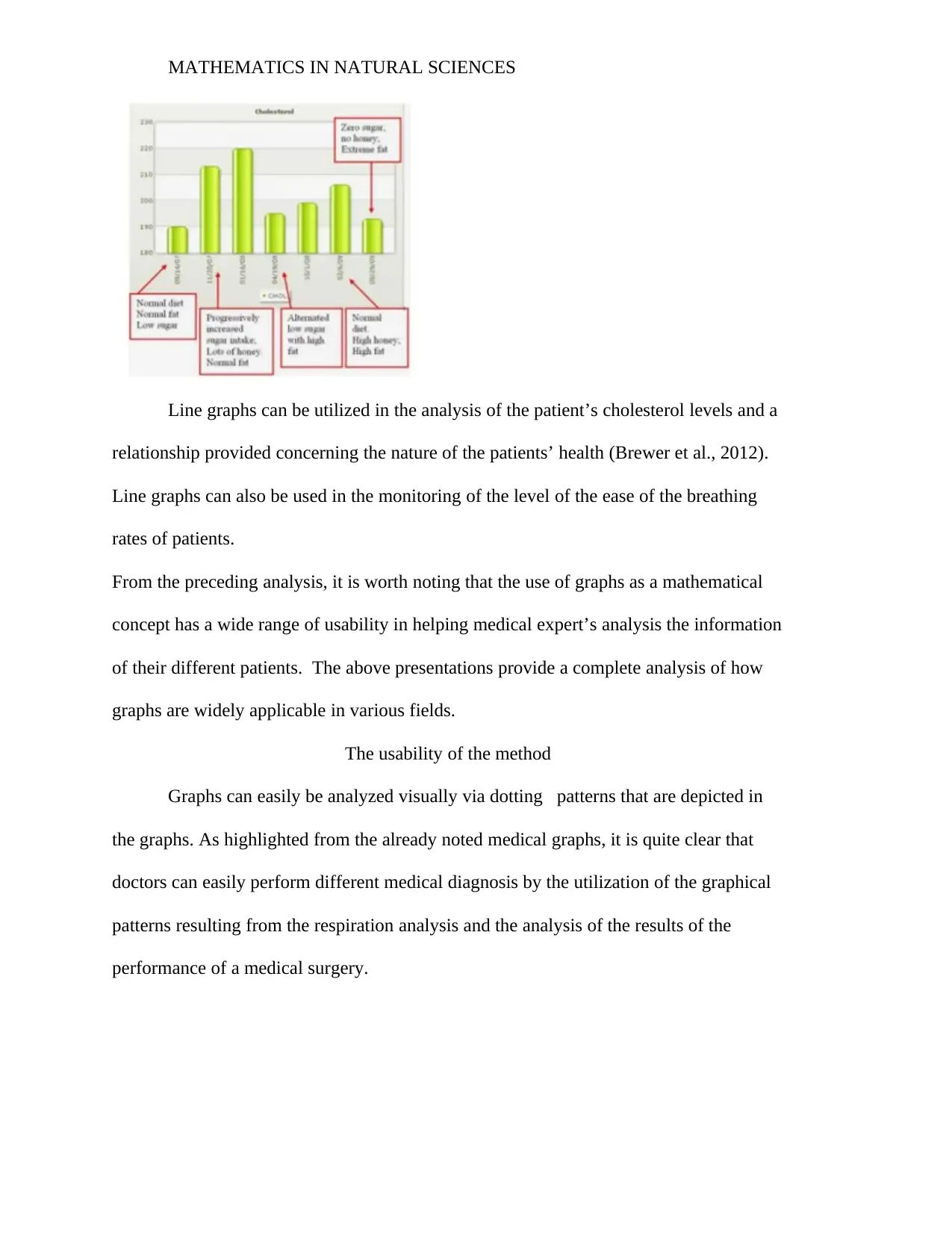
MATHEMATICS IN NATURAL SCIENCES
Line graphs can be utilized in the analysis of the patient’s cholesterol levels and a
relationship provided concerning the nature of the patients’ health (Brewer et al., 2012).
Line graphs can also be used in the monitoring of the level of the ease of the breathing
rates of patients.
From the preceding analysis, it is worth noting that the use of graphs as a mathematical
concept has a wide range of usability in helping medical expert’s analysis the information
of their different patients. The above presentations provide a complete analysis of how
graphs are widely applicable in various fields.
The usability of the method
Graphs can easily be analyzed visually via dotting patterns that are depicted in
the graphs. As highlighted from the already noted medical graphs, it is quite clear that
doctors can easily perform different medical diagnosis by the utilization of the graphical
patterns resulting from the respiration analysis and the analysis of the results of the
performance of a medical surgery.
Line graphs can be utilized in the analysis of the patient’s cholesterol levels and a
relationship provided concerning the nature of the patients’ health (Brewer et al., 2012).
Line graphs can also be used in the monitoring of the level of the ease of the breathing
rates of patients.
From the preceding analysis, it is worth noting that the use of graphs as a mathematical
concept has a wide range of usability in helping medical expert’s analysis the information
of their different patients. The above presentations provide a complete analysis of how
graphs are widely applicable in various fields.
The usability of the method
Graphs can easily be analyzed visually via dotting patterns that are depicted in
the graphs. As highlighted from the already noted medical graphs, it is quite clear that
doctors can easily perform different medical diagnosis by the utilization of the graphical
patterns resulting from the respiration analysis and the analysis of the results of the
performance of a medical surgery.
⊘ This is a preview!⊘
Do you want full access?
Subscribe today to unlock all pages.

Trusted by 1+ million students worldwide
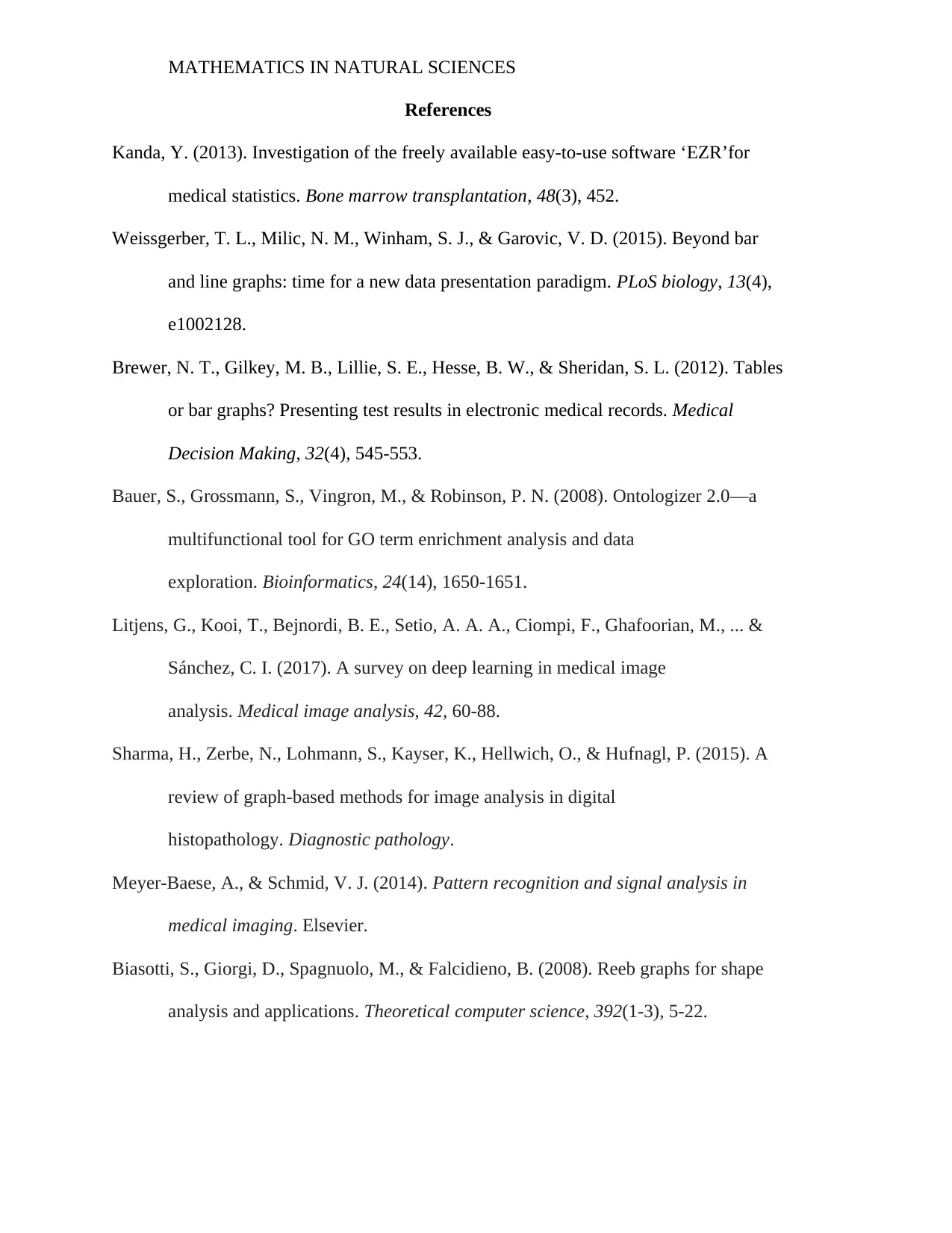
MATHEMATICS IN NATURAL SCIENCES
References
Kanda, Y. (2013). Investigation of the freely available easy-to-use software ‘EZR’for
medical statistics. Bone marrow transplantation, 48(3), 452.
Weissgerber, T. L., Milic, N. M., Winham, S. J., & Garovic, V. D. (2015). Beyond bar
and line graphs: time for a new data presentation paradigm. PLoS biology, 13(4),
e1002128.
Brewer, N. T., Gilkey, M. B., Lillie, S. E., Hesse, B. W., & Sheridan, S. L. (2012). Tables
or bar graphs? Presenting test results in electronic medical records. Medical
Decision Making, 32(4), 545-553.
Bauer, S., Grossmann, S., Vingron, M., & Robinson, P. N. (2008). Ontologizer 2.0—a
multifunctional tool for GO term enrichment analysis and data
exploration. Bioinformatics, 24(14), 1650-1651.
Litjens, G., Kooi, T., Bejnordi, B. E., Setio, A. A. A., Ciompi, F., Ghafoorian, M., ... &
Sánchez, C. I. (2017). A survey on deep learning in medical image
analysis. Medical image analysis, 42, 60-88.
Sharma, H., Zerbe, N., Lohmann, S., Kayser, K., Hellwich, O., & Hufnagl, P. (2015). A
review of graph-based methods for image analysis in digital
histopathology. Diagnostic pathology.
Meyer-Baese, A., & Schmid, V. J. (2014). Pattern recognition and signal analysis in
medical imaging. Elsevier.
Biasotti, S., Giorgi, D., Spagnuolo, M., & Falcidieno, B. (2008). Reeb graphs for shape
analysis and applications. Theoretical computer science, 392(1-3), 5-22.
References
Kanda, Y. (2013). Investigation of the freely available easy-to-use software ‘EZR’for
medical statistics. Bone marrow transplantation, 48(3), 452.
Weissgerber, T. L., Milic, N. M., Winham, S. J., & Garovic, V. D. (2015). Beyond bar
and line graphs: time for a new data presentation paradigm. PLoS biology, 13(4),
e1002128.
Brewer, N. T., Gilkey, M. B., Lillie, S. E., Hesse, B. W., & Sheridan, S. L. (2012). Tables
or bar graphs? Presenting test results in electronic medical records. Medical
Decision Making, 32(4), 545-553.
Bauer, S., Grossmann, S., Vingron, M., & Robinson, P. N. (2008). Ontologizer 2.0—a
multifunctional tool for GO term enrichment analysis and data
exploration. Bioinformatics, 24(14), 1650-1651.
Litjens, G., Kooi, T., Bejnordi, B. E., Setio, A. A. A., Ciompi, F., Ghafoorian, M., ... &
Sánchez, C. I. (2017). A survey on deep learning in medical image
analysis. Medical image analysis, 42, 60-88.
Sharma, H., Zerbe, N., Lohmann, S., Kayser, K., Hellwich, O., & Hufnagl, P. (2015). A
review of graph-based methods for image analysis in digital
histopathology. Diagnostic pathology.
Meyer-Baese, A., & Schmid, V. J. (2014). Pattern recognition and signal analysis in
medical imaging. Elsevier.
Biasotti, S., Giorgi, D., Spagnuolo, M., & Falcidieno, B. (2008). Reeb graphs for shape
analysis and applications. Theoretical computer science, 392(1-3), 5-22.
1 out of 7
Related Documents
Your All-in-One AI-Powered Toolkit for Academic Success.
+13062052269
info@desklib.com
Available 24*7 on WhatsApp / Email
![[object Object]](/_next/static/media/star-bottom.7253800d.svg)
Unlock your academic potential
Copyright © 2020–2025 A2Z Services. All Rights Reserved. Developed and managed by ZUCOL.





